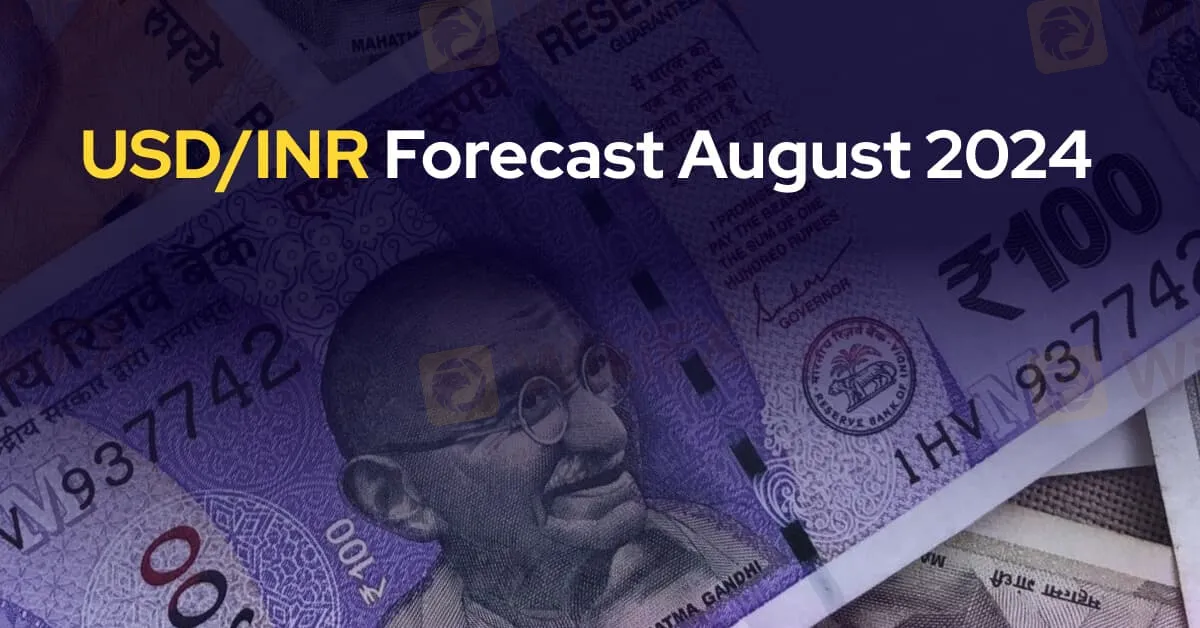简体中文
繁體中文
English
Pусский
日本語
ภาษาไทย
Tiếng Việt
Bahasa Indonesia
Español
हिन्दी
Filippiiniläinen
Français
Deutsch
Português
Türkçe
한국어
العربية
USD/INR Forecast August 2024
Abstract:As we step into August 2024, the USD/INR exchange rate begins at 83.69 Rupees. This forecast aims to comprehensively analyze the expected trends and potential movements in the USD/INR pair throughout the month.

As we step into August 2024, the USD/INR exchange rate begins at 83.69 Rupees. This forecast aims to comprehensively analyze the expected trends and potential movements in the USD/INR pair throughout the month.
Opening Rate
The USD/INR pair started August at 83.69 Rupees, reflecting the exchange rate at the close of July. This rate is a crucial benchmark as it sets the stage for analyzing the monthly trajectory of the currency pair.
Highs and Lows
For August 2024, the forecasted high for the USD/INR pair is 85.30 Rupees. This indicates potential periods of Rupee depreciation against the US Dollar. On the other hand, the projected low is 82.39 Rupees, suggesting phases where the Rupee might strengthen.
Average Rate
The average exchange rate for August is forecasted to be 83.86 Rupees. This average is derived from the anticipated monthly fluctuations and provides a midpoint that traders and investors can use for a balanced view.
End-of-Month Forecast
By the end of August 2024, the USD/INR rate is expected to reach 84.04 Rupees. This marks a slight increase from the opening rate, translating to a month-on-month change of approximately 0.4%.
Analysis of Factors Influencing the USD/INR Forecast
Several factors contribute to the fluctuations in the USD/INR exchange rate:
Economic Data Releases: Key economic indicators from both the US and India, such as GDP growth rates, inflation, and employment figures, will significantly impact the exchange rate. Strong economic data from the US could bolster the Dollar, while positive Indian economic indicators might strengthen the Rupee.
Monetary Policy: Decisions by the Federal Reserve and the Reserve Bank of India regarding interest rates and other monetary policies will influence the currency pair. An interest rate hike by the Fed could lead to a stronger Dollar, while accommodative policies from the RBI could support the Rupee.
Global Market Sentiment: Geopolitical events, trade relations, and overall market sentiment will also play a role. For instance, any escalation in geopolitical tensions could lead to a flight to safety, strengthening the Dollar.
Commodity Prices: As a significant importer of oil, fluctuations in crude oil prices can impact the Rupee. Rising oil prices typically lead to a weaker Rupee due to increased import costs.
Investor Behavior: Market participants' sentiment and speculative activities often lead to short-term volatility in the exchange rate.
Conclusion
The USD/INR pair is set to experience a dynamic August 2024, with the exchange rate ranging between 82.39 and 85.30 Rupees. The average rate of 83.86 provides a balanced view of the expected fluctuations, while the end-of-month forecast of 84.04 suggests a modest appreciation of the Rupee. By staying informed about the economic indicators and global events, traders and investors can navigate the potential volatility in the USD/INR pair effectively.

Disclaimer:
The views in this article only represent the author's personal views, and do not constitute investment advice on this platform. This platform does not guarantee the accuracy, completeness and timeliness of the information in the article, and will not be liable for any loss caused by the use of or reliance on the information in the article.
Read more

Top 10 Trading Indicators Every Forex Trader Should Know
Master the top 10 Forex trading indicators to analyze real-time Forex quotes, trends, and market signals. Learn strategies to boost accuracy and avoid mistakes.

WikiEXPO Global Expert Interview: Simone Martin—— Exploring Financial Regulation Change
In the midst of financial innovation and regulation, WikiGlobal, the organizer of WikiEXPO, stays abreast of industry trends and conducts a series of insightful and distinctive interviews on pivotal topics. We are delighted to have the privilege of inviting Simone Martin for an in-depth conversation this time.

CySEC Settles Compliance Case with Fxview Operator Charlgate Ltd
Discover how CySEC resolved compliance issues with Charlgate Ltd, the operator of Fxview, through a €50,000 settlement. Explore the investigation, regulatory measures, and CySEC's new website designed for improved accessibility and transparency.

TradingView Launches Liquidity Analysis Tool DEX Screener
Discover TradingView's DEX Screener, a powerful tool for analyzing decentralized exchange trading pairs. Access metrics like liquidity, trading volume, and FDV to make smarter, data-driven trading decisions.
WikiFX Broker
Latest News
Geopolitical Events: What They Are & Their Impact?
Volkswagen agrees deal to avoid Germany plant closures
Top 10 Trading Indicators Every Forex Trader Should Know
TradingView Launches Liquidity Analysis Tool DEX Screener
MultiBank Group Wins Big at Traders Fair Hong Kong 2024
WikiEXPO Global Expert Interview: Simone Martin—— Exploring Financial Regulation Change
'Young investors make investment decisions impulsively to keep up with current trends' FCA Reveals
Why Do You Feel Scared During Trade Execution?
CySEC Settles Compliance Case with Fxview Operator Charlgate Ltd
Malaysian Influencer Detained in Taiwan Over Alleged Role in Fraud Scheme
Currency Calculator


